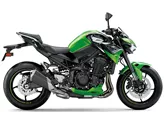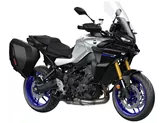Yamaha MT-10 2022 vs. Kawasaki Z900 RS 2022

Yamaha MT-10 2022

Kawasaki Z900 RS 2022
Overview - Yamaha MT-10 2022 vs Kawasaki Z900 RS 2022
In terms of engine and drive train, both the Yamaha MT-10 2022 and the Kawasaki Z900 RS 2022 have inline 4-cylinder engines with liquid cooling and fuel injection systems. However, the Yamaha MT-10 has a more powerful engine, producing 166 HP compared to the Kawasaki Z900 RS's 111 HP. The Yamaha MT-10 also has higher torque at 112 Nm compared to the Kawasaki Z900 RS's 98.6 Nm. Additionally, the Yamaha MT-10 has a larger displacement at 998ccm compared to the Kawasaki Z900 RS's 948ccm.
In terms of suspension, both bikes have upside-down telescopic forks at the front and swing arm suspension at the rear. The Yamaha MT-10 offers more adjustability with compression, preload, and rebound adjustments for both the front and rear suspension. The Kawasaki Z900 RS only offers preload and rebound adjustments for the rear suspension. Both bikes have aluminum swing arms, but the Yamaha MT-10 has an aluminum frame while the Kawasaki Z900 RS has a steel frame.

Yamaha MT-10 2022
In terms of braking, both bikes have double disk brakes at the front with four-piston calipers. The Yamaha MT-10 has larger front brake disks with a diameter of 320mm compared to the Kawasaki Z900 RS's 300mm front brake disks. Both bikes have ABS and traction control as advanced rider assistance systems.
In terms of dimensions and weights, both bikes have 17-inch wheels with a front tire width of 120mm. The Yamaha MT-10 has a wider rear tire at 190mm compared to the Kawasaki Z900 RS's 180mm rear tire. The Yamaha MT-10 has a shorter wheelbase at 1405mm compared to the Kawasaki Z900 RS's 1470mm wheelbase. Both bikes have a seat height of 835mm and a fuel tank capacity of 17 liters. The Yamaha MT-10 has a slightly lower kerb weight with ABS at 212kg compared to the Kawasaki Z900 RS's 215kg kerb weight with ABS.
In terms of strengths, the Yamaha MT-10 2022 offers a lovely CP4 engine, a great electronics package, a distinctive look, a comfortable seating position, and easy-to-read gauges. It also features cornering ABS, which enhances safety during cornering. On the other hand, the Kawasaki Z900 RS 2022 has a beautiful design, a powerful engine, stable handling, powerful brakes, a comfortable seating position, and analogue displays. The adjustable levers on the Kawasaki Z900 RS provide added customization options.

Kawasaki Z900 RS 2022
In terms of weaknesses, the Yamaha MT-10 2022 has a non-adjustable clutch lever and lacks steel braided brake hoses. The display on the Yamaha MT-10 is also somewhat small. On the other hand, the Kawasaki Z900 RS 2022 does not offer an optional quickshifter.
Overall, both the Yamaha MT-10 2022 and the Kawasaki Z900 RS 2022 are impressive naked bikes with their own unique strengths and weaknesses. The Yamaha MT-10 offers a more powerful engine and more advanced suspension adjustments, while the Kawasaki Z900 RS boasts a beautiful design and adjustable levers. Ultimately, the choice between the two will depend on individual preferences and priorities.
Technical Specifications Yamaha MT-10 2022 compared to Kawasaki Z900 RS 2022
Pros and Cons in comparison
Pros and Cons in comparison
Yamaha MT-10 2022

The new MT-10 is a really successful evolution of its predecessor, but remains completely true to its character. The new electronics package with a 6-axis IMU is a blast, all features are so well coordinated and work so well together that the rider is optimally supported by the electronics in every situation without being overbearingly patronised. The rest of the components in the chassis and brakes are completely in order and the Mad Max-Brachialo style look has been toned down a little in direct comparison to the predecessor, but still remains unique and clearly recognisable as an MT-10.
Kawasaki Z900 RS 2022

The Z900 RS enjoys a large fan base and in 2022 it once again proves why it is so popular. The powerful engine scores with pulling power and a wonderful sound that is not too obtrusive. The handling feels natural and presents no challenges. Only a quickshifter would suit the bike - even if that doesn't quite fit the retro idea.
Price Comparison Avarage Market Price Yamaha MT-10 vs Kawasaki Z900 RS
There are a few key differences between a Yamaha MT-10 2022 and a Kawasaki Z900 RS 2022. In terms of price, the actual average price of a Yamaha MT-10 2022 is about 21% higher. Compared to Kawasaki Z900 RS 2022 there are more Yamaha MT-10 2022 bikes available on the 1000PS.de Marketplace, specifically 76 compared to 22. It takes less time to sell a Kawasaki Z900 RS with 127 days compared to 151 days for the Yamaha MT-10. Since model year 2016 1000PS.de editors have written 32 reviews for the Yamaha MT-10 and 26 reviews for the Kawasaki Z900 RS since model year 2018. The first review for the Yamaha MT-10 was published on 11/17/2015 and now has more than 20,700 views. This compares to more than 63,700 views for the first review on Kawasaki Z900 RS published on 9/6/2017.





















